
The year in gear: Hardware picks for 2021
By The Article Master on
As the year draws to a close, we're been taking a look back at some of the best gear you could buy in 2021. Benn Jordan, Venus Theory, The Messy Desk, Bo Beats and Starsky Carr disclose their favorite pieces of hardware available in 2021 below... happily, they didn't entirely restrict themselves to gear that came out this year, instead taking a much more open-ended approach. The question asked was: what is the best gear you can get in 2021?
Benn Jordan's Pick: Arturia Polybrute
Given the nearly ecstatic nature of his own overview video (below), it shouldn't be surprising that Benn Jordan (the Flashbulb) chose Arturia's Polybrute as his top synth pick of 2021.
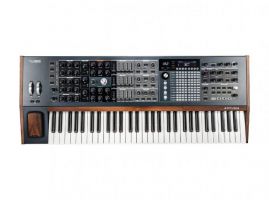 A deceptively simple oscillator section is the beating heart of the Polybrute: there are two analog oscillators which each have their own unique characteristics and can be blended in a way to create luscious pads, sharp FM leads, and nasty sync'd basslines. The first oscillator utilizes a Metalizer to mangle the waveform and the second features a Sub oscillator. Both oscillators have the same saw-to-triangle shapes with an added pulse/square wave that can be added and each has their own dedicated mix level control. In the mixer section, there's a third Noise level control that lets you bring in the noise oscillator. All three of these can be routed to one or both of the on-board filters: the Steiner or the Ladder. These can be run in series or parallel with the ability to morph between the two stages; the Stiener is a multi-mode-morphing filter while the Ladder is a classic lowpass. With the routing and quality of the voices, VCAs, and filters, it's really easy to finesse amazing sounds.
A deceptively simple oscillator section is the beating heart of the Polybrute: there are two analog oscillators which each have their own unique characteristics and can be blended in a way to create luscious pads, sharp FM leads, and nasty sync'd basslines. The first oscillator utilizes a Metalizer to mangle the waveform and the second features a Sub oscillator. Both oscillators have the same saw-to-triangle shapes with an added pulse/square wave that can be added and each has their own dedicated mix level control. In the mixer section, there's a third Noise level control that lets you bring in the noise oscillator. All three of these can be routed to one or both of the on-board filters: the Steiner or the Ladder. These can be run in series or parallel with the ability to morph between the two stages; the Stiener is a multi-mode-morphing filter while the Ladder is a classic lowpass. With the routing and quality of the voices, VCAs, and filters, it's really easy to finesse amazing sounds.
Finally, the modulation, because that is where the expandabilities become virtually endless. Across 3 LFOs, 3 envelopes, the Morphee controller, aftertouch, and the ribbon controller, there is a lot to cover. Suffice to say: anything can modulate everything. Front and center is the Matrix, which can look daunting, but basically you find your modulation source on the left, tap one of the squares to the right and you're on your way to creating interesting, evolving patches. Like any instrument, it requires practice and patience, but it is fairly easy to get up and running with a full bevy of excellent presets. The Motion Recorder is another handy feature that allows you to record your knob and/or slider twiddling so each time you press a key, that same gesticulation happens. You can change the rate to happen faster or slower than you gestured. Combine that with the Arp/Sequencer and you have, essentially, a living organism.
A full featured, digital effects section is at the end of the chain with delay, reverb, and modulation effects each with their own parameters and flavors. Of course, these can also be added to the modulation matrix. An instrument this robust and full featured is hard to convey in words, let alone just a few paragraphs, so we suggest you try it in person for the full, ecstatic experience of the Polybrute. Just be sure to give yourself ample time to zone out.
Venus Theory's Pick: Arturia Keystep Pro
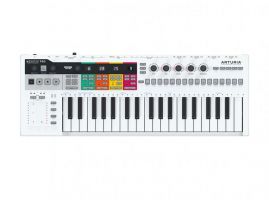 Keystep Pro didn't come along this year...but despite that, there's still nothing quite like it. That's why it was Venus Theory's top pick for gear you can get in 2021: it is a powerful multichannel controller capable of acting as the brain of virtually any electronic music production or performance setup.
Keystep Pro didn't come along this year...but despite that, there's still nothing quite like it. That's why it was Venus Theory's top pick for gear you can get in 2021: it is a powerful multichannel controller capable of acting as the brain of virtually any electronic music production or performance setup.
More than just a MIDI controller, the Keystep Pro from Arturia is a compact powerhouse for composition. Centered around a 4-track sequencer, these independent tracks can be routed to any of the 16 MIDI channels or 4 CV outputs. The first track also has a Drum mode that makes use of the 8 Drum Gates. Aside from the sequencing options, the feel of the keyboard is wonderful with 37 slim keys that offer aftertouch and velocity sensitivity, so expressivity is easily achieved. Each of the four sequencing tracks is independent and can be programmed to have up to 64 steps. Programming the Keystep is pretty straight forward with the option to manually program notes in, or you can record your notes in real time. When recording the notes, you can have the sequence be quantized to the tempo/divisions or not allowing for more organic patterns to emerge. The velocity, aftertouch, mod wheel, and CC knobs are also recorded. The patterns can be left at that, however, the performance controls bring sequencing to the next level. You can transpose all or some of the tracks, randomize the step order, randomize the step trigger probability, randomize the notes, dynamically shift pitches that are quantized to a scale, nudge the entire sequence, add individual swing per step—the list can go on.
Performance was well thought out when designing this interface and everything is easily accessible thanks to the many buttons and well placed indicator lights. The Keystep Pro is a fun instrument to play and with so many ports of expandability this can really be the center of your studio and performance workflow. The 4 Voice CV outs each have Pitch, Mod/Velocity, and Gate outputs and the addition of 8 individual Gate Outs for the Drum sequencing means you can power a full Eurorack with ease. The incredibly handy addition of two MIDI outs makes connecting multiple devices a breeze and syncing everything is simple, too, with dedicated clock outputs.
For versatility and musicality, the KeyStep Pro is hard to beat. Its compact size fits easily in any studio and its connectivity can power you as you expand your setup. Excellent software, customizability, and creative performance options: it's everything you could want in a controller.
The Messy Desk's Pick: Elektron Digitakt
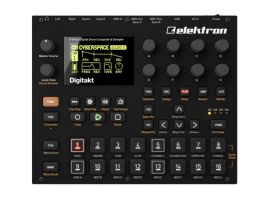 Dan from The Messy Desk not only made the wise move to purchase a Digitakt this year, but also highlights it as his favorite product of the year. Marketed as a drum machine, Elektron's Digitakt is a fantastic sampler and sequencer that goes above and beyond many of the drum machines found on the market to this day. The Digitakt can sample internally and externally, be used as an audio interface, and performs not only eight audio tracks, but also eight additional MIDI tracks. To start, the eight audio tracks have tons of flexibility over their timbre with sample editing, a filter and amplitude section, bitcrushing and overdrive, and two flexible LFOs that can be assigned to almost any parameter. These audio tracks not only play back the sound or sample loaded to the track, but can swap between up to 127 different designable sounds via the Sound Pool option, and that's per project. Incorporating your other synths and machines is simple with the eight MIDI tracks—capable of setting up MIDI channel, program bank and changes, velocity, pitch bend, and even eight specific CCs.
Dan from The Messy Desk not only made the wise move to purchase a Digitakt this year, but also highlights it as his favorite product of the year. Marketed as a drum machine, Elektron's Digitakt is a fantastic sampler and sequencer that goes above and beyond many of the drum machines found on the market to this day. The Digitakt can sample internally and externally, be used as an audio interface, and performs not only eight audio tracks, but also eight additional MIDI tracks. To start, the eight audio tracks have tons of flexibility over their timbre with sample editing, a filter and amplitude section, bitcrushing and overdrive, and two flexible LFOs that can be assigned to almost any parameter. These audio tracks not only play back the sound or sample loaded to the track, but can swap between up to 127 different designable sounds via the Sound Pool option, and that's per project. Incorporating your other synths and machines is simple with the eight MIDI tracks—capable of setting up MIDI channel, program bank and changes, velocity, pitch bend, and even eight specific CCs.
Equally if not more powerful, Elektron's brilliant sequencer pushes Digitakt to some amazing boundaries with probability, retriggering, automation, and more. Initially, each track on Digitakt follows a simple 16-step sequence a tempo, quantized to the beat—this is simply a canvas for you to create beautiful sequences with control over each track's step length (up to 64) & clock division/multiplication AND each step's microtiming & retrigger conditions. On top of all that flexibility you still have a variety of conditional and parameter locking that allow you to give individual steps conditions on when they're played and whether or not to follow the base parameters or a specific set of parameters.
What ties Digitakt all together is the stellar master bus, showcasing eight levels for mixing your tracks, delay and reverb send effects, and a master bus compressor. What's really special is the master bus compressor can be sidechained internally or externally, and as of recent firmware updates, you can use Digitakt to mix in external sources that can be processed through the master bus compressor. There's even more depth for each of the previously listed topics as well as performance features, audio routing, and integration with your computer. If you're on the fence of its ability to enhance your productions and performances, we feature and talk about the Elektron Digitakt in many of our videos.
BoBeats's Pick: Native Instruments Maschine+
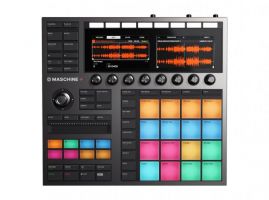 Having the creative and manipulative power of a computer without using a computer is quite hard to achieve, and yet Native Instruments made that concept a reality with their fantastic Maschine+. Already a hit as a mini-DAW, drum sequencer, and performance & production controller, Maschine has been one of the most highly-rated and sought after production and beat making tools for the past 11+ years. Version after version, NI really hit it out of the park with the MkIII iteration with OLED displays, audio I/O, performative touchstrip, and an overall better build quality. Expanding upon that by making Maschine self-sufficient and fully independent from the computer, we can understand why Maschine+ was BoBeats's favorite piece of gear for the year.
Having the creative and manipulative power of a computer without using a computer is quite hard to achieve, and yet Native Instruments made that concept a reality with their fantastic Maschine+. Already a hit as a mini-DAW, drum sequencer, and performance & production controller, Maschine has been one of the most highly-rated and sought after production and beat making tools for the past 11+ years. Version after version, NI really hit it out of the park with the MkIII iteration with OLED displays, audio I/O, performative touchstrip, and an overall better build quality. Expanding upon that by making Maschine self-sufficient and fully independent from the computer, we can understand why Maschine+ was BoBeats's favorite piece of gear for the year.
Looking at the Maschine+'s internal software alone, you have a healthy amount of tools for sound designing and mixing any kind of material you throw at it. On top of all the amazing Maschine instruments, samples, and effects, you also have access to some of NI's amazingly renowned soft synths and effect plugins for even further sonic creation. One of the most amazing instruments inside of Maschine+ is the sampler, and with the inclusion of two line inputs and one dynamic mic input, you can sample external sources directly into Maschine+ without the immediate need for an audio interface. Of course, with the two USB host ports and the SD slot, you have room for not only expanding your audio I/O capabilities, but also project and sample storage as well as room for bringing in external MIDI gear such as keyboards and fader/knob controllers.
Performing and producing on Maschine+ is a cinch with the amount of control you're presented, including velocity and pressure sensitive RGB pads, robust and smooth knobs, as well as a flexible and multi-faceted touch strip. Maschine+ offers a multitude of ways for entering notes and parameter changes, be it per step, live recorded, or even different pad and performance modes, such as keyboard, chord, step, and many more. For further detail, the OLED screens let you see all the details of the Maschine sequencer for easy and precision editing. Easily create patterns to sequence into fully fledged tracks, and mix them on the fly in the mixing view, great for balancing levels, panning, and creating sends and returns. Group your instruments and tracks into eight easy to access groupings, represented by the buttons A through G, and if you need more, Maschine+ can always create additional groups for your personal needs.
If you need more control or want to take your projects to your other DAW for further production or mixing, Maschine+ works immediately with the Maschine software on your computer. Hook your Maschine+ up to a speaker system to perform your tracks in the club, on stage, or even while busking with the provided balanced line outputs. As long as you have a solid power source, a pair of headphones, and some musical inspiration, Native Instrument's Maschine+ brings you some of the highest quality of production and beat making while in the studio or on the go.
Starsky Carr's Picks: Waldorf M + Sequential Take 5
With all of the neat synths that came out this year, anyone would be hard pressed to pick just one favorite. So in narrowing it down to just two, Starsky Carr's picks are the Waldorf M and Sequential Take 5. Both instruments look back on the history of their respective brands as premier designers of wavetable and analog synthesizers, respectively, but reimagined in a modern package.
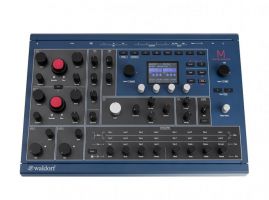 The Waldorf M draws upon a rich legacy of wavetable instruments, including the PPG Wave and Waldorf's own Microwave. In fact, it comes from the factory with a number of the same original wavetables from those instruments, but they see a new lease on life with all of the modern enhancements that M provides. With oscillators that can behave like the classic Microwave 1 or more modern Microwave II/XT, a true analog filter based around the SSI 2144 chip, a stereo VCA, and a number of LFOs and envelope generators, M delivers on its promise for traditional, wavetable synthesis workflows.
The Waldorf M draws upon a rich legacy of wavetable instruments, including the PPG Wave and Waldorf's own Microwave. In fact, it comes from the factory with a number of the same original wavetables from those instruments, but they see a new lease on life with all of the modern enhancements that M provides. With oscillators that can behave like the classic Microwave 1 or more modern Microwave II/XT, a true analog filter based around the SSI 2144 chip, a stereo VCA, and a number of LFOs and envelope generators, M delivers on its promise for traditional, wavetable synthesis workflows.
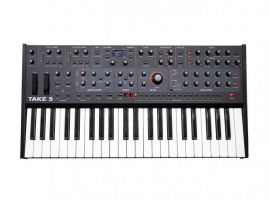 Fresh off of their reissue of the Prophet-5, Sequential's Take 5 encapsulates a lot of similar concepts in a package that is comparatively much more affordable. Five voices, each having two VCOs paired with the same rich filter from the Prophet-5, combined with effects, an arpeggiator, and sequencer make the Take 5 a synth that easily holds its own when compared with other two or three times its price. But features aside, it simply sounds full, lush, and really good, just as we'd hope any good analog polysynth to be.
Fresh off of their reissue of the Prophet-5, Sequential's Take 5 encapsulates a lot of similar concepts in a package that is comparatively much more affordable. Five voices, each having two VCOs paired with the same rich filter from the Prophet-5, combined with effects, an arpeggiator, and sequencer make the Take 5 a synth that easily holds its own when compared with other two or three times its price. But features aside, it simply sounds full, lush, and really good, just as we'd hope any good analog polysynth to be.
Whether you're a die-hard analog devotee or fully embrace the digital revolution, Take 5 and M just might be one (or both) of the things you're looking for.
About the author
This article is provided in collaboration with Perfect Circuit. Perfect Circuit Audio is the go-to nexus for everything related to hardware synthesizers, pro audio equipment and more—with a particular focus towards boutique and high-end devices.
This article makes use of affiliate links. In the event you make a purchase using these links, KVR Audio receives a commission at no extra cost to yourself. We thank you for your support.
Read More Best of

Discussion
Please log in to join the discussion










